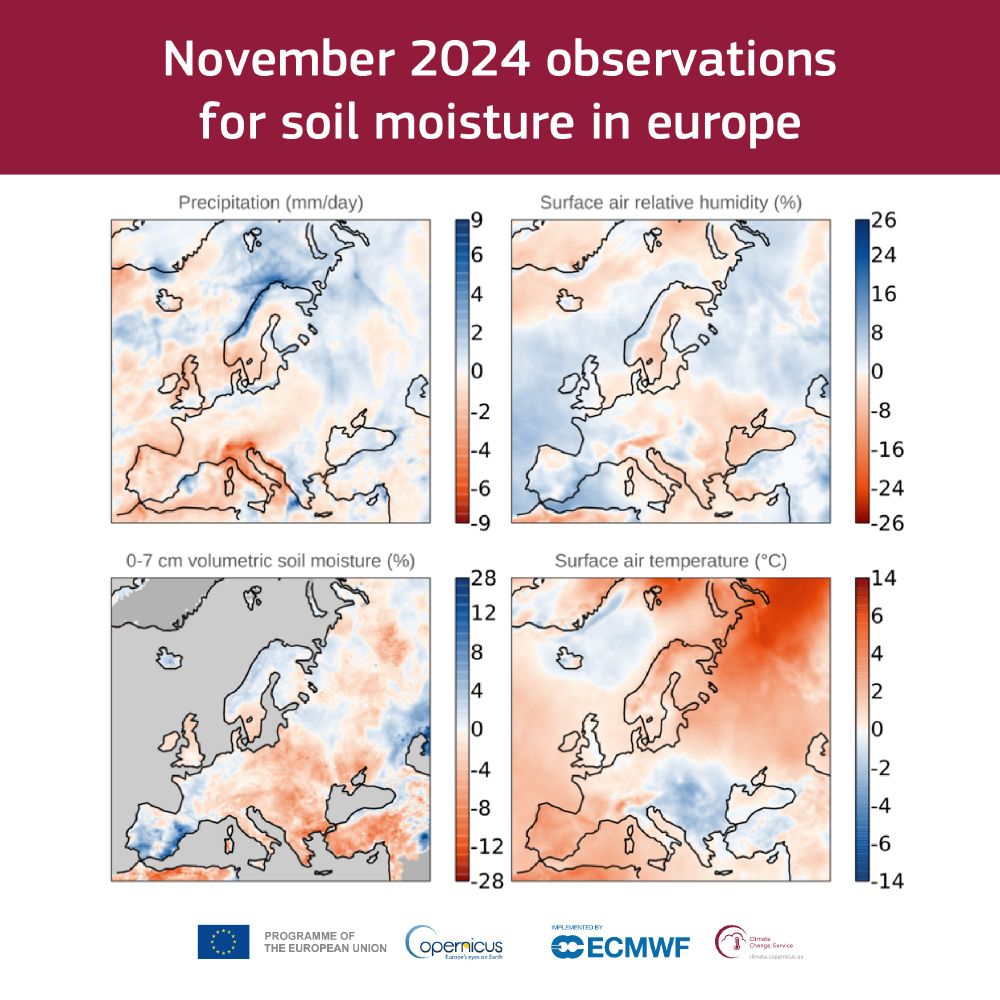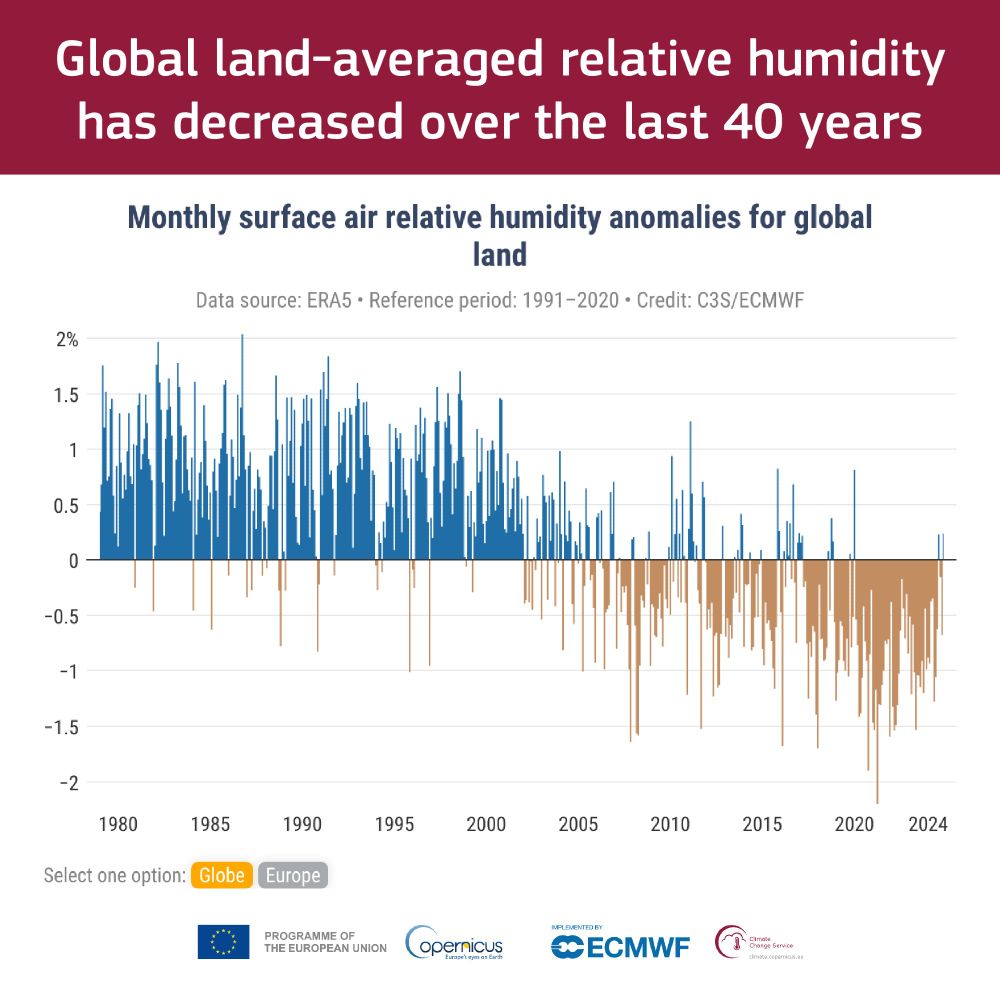Do tropical systems ever fully merge via the Fujiwhara effect? Here's a classic example from 2022 in the Indian Ocean: TC Vernon and Invest 93S.
30.09.2025 17:31 — 👍 4 🔁 1 💬 1 📌 0
He hablado con @canalextremadura sobre cómo la IA puede ayudarnos a atribuir olas de calor al cambio climático. 🌍🔥 Una herramienta clave para comunicar de forma más rápida y precisa sus impactos.
26.08.2025 16:57 — 👍 0 🔁 0 💬 0 📌 0
6) This approach opens the door to operational attribution systems that can assess climate change impacts even before an event unfolds, thereby improving preparedness and response.
More details in the paper: agupubs.onlinelibrary.wiley.com/doi/10.1029/...
12.08.2025 16:59 — 👍 0 🔁 0 💬 0 📌 0

5) In every case, human-made climate change made the heatwaves more intense.
We also found that sea surface temperature forcing can modulate the signal in some cases — but atmospheric initial conditions used to perturb the counterfactual forecasts are the main driver.
12.08.2025 16:57 — 👍 0 🔁 0 💬 1 📌 0

4) We applied this to 4 major heatwaves worldwide 🌍 using:
• FourCastNet-v2
• Pangu-Weather
• NeuralGCM (AI + physics hybrid)
All three captured key dynamics like persistent high-pressure systems and can predict heawaves accurately 5 days in advance.
12.08.2025 16:55 — 👍 0 🔁 0 💬 1 📌 0

3) Our method uses a pseudo–global warming (PGW) framework:
• Run forecasts for today’s climate 🌡️
• Run forecasts for a preindustrial climate 🕰️
Only the thermodynamic initial conditions change — atmospheric circulation at the initial state stays the same.
12.08.2025 16:54 — 👍 0 🔁 0 💬 1 📌 0

2) Traditional attribution methods are powerful, but they can take days, weeks and need heavy computing.
Here, we tested a faster route using three state-of-the-art AI models that run in minutes, without supercomputers.
12.08.2025 16:53 — 👍 1 🔁 0 💬 1 📌 0

AI‐Driven Weather Forecasts to Accelerate Climate Change Attribution of Heatwaves
Artificial intelligence (AI) weather prediction models provide reliable short-term forecasts of major heatwaves (HWs) across diverse climate regions A hybrid method that combines AI weather forec...
1) 🔥 New research in Earth’s Future!
We show that AI weather prediction models, combined with climate simulations, can be used to estimate the influence of human-made climate change on heatwaves.
👉 tinyurl.com/a5b5ndby
@csic.es @igeociencias.bsky.social
#ClimateChange #AI #Heatwaves
12.08.2025 16:52 — 👍 12 🔁 5 💬 1 📌 0

☀️Un método basado en #IA predice el papel del #cambioclimático en las olas de calor
👩💻El modelo del @igeociencias.bsky.social determina la intensidad de estos eventos extremos, días antes de que ocurran
🌏También muestra la influencia del cambio climático en su severidad
➡️http://tiny.cc/b1xq001
12.08.2025 09:03 — 👍 14 🔁 9 💬 0 📌 1

Pronósticos meteorológicos basados en inteligencia artificial para acelerar la atribución del cambio climático a las olas de calor.
igeo.ucm-csic.es/pronosticos-...
#IGEOinvestiga
@bernat-jimenez.bsky.social
06.08.2025 07:11 — 👍 5 🔁 2 💬 0 📌 0
Encantado de haber participado en esta edición de #GeocienciasEnElCole hablando sobre cambio climático y extremos meteorológicos.
12.06.2025 08:19 — 👍 3 🔁 1 💬 0 📌 0
🌀 ¡Explorando los bloqueos atmosféricos! 🌍 Resumen del estudio sobre cómo la alta resolución mejora su simulación, liderado por @paolodeluca.bsky.social en el BSC. #CienciaClimática #Meteorología
28.01.2025 09:42 — 👍 5 🔁 1 💬 0 📌 0
El encuentro de dos mareas revela un fascinante fenómeno de interferencia de las olas en el río Qiantang (China).
(autor desconocido)
13.12.2024 07:44 — 👍 61 🔁 28 💬 0 📌 1


#C3S Climate Bulletin: what did we observe in November?
🌦️ Western and Central Europe: Below-average precipitation
💧 U.S. and Australia: Wetter-than-average
☀️ South America: Drought in several regions, wetter-than-average in others
All details: climate.copernicus.eu/precipitatio...
09.12.2024 12:57 — 👍 23 🔁 7 💬 0 📌 1
Earth physics. Science. UCLM Professor, Castilla-La Mancha, Spain. Basketball. Bruce. Saramago. ÚltimodelaFila. A hombros de gigantes
Plataforma del CSIC para el clima y los servicios climáticos.
https://pti-clima.csic.es/
Contribuimos al conocimiento del cambio climático para favorecer la adaptación de nuestra sociedad.
CA22162 - FutureMed: A TRANSDISCIPLINARY NETWORK TO BRIDGE CLIMATE SCIENCE AND IMPACTS ON SOCIETY.
futuremedaction.eu
Spanish Association of Climatology. Más de dos décadas fomentando el estudio del clima y el progreso de las ciencias de la atmósfera en España. Impulsando y difundiendo investigaciones interdisciplinares.
ℹ️ aeclim.org
Post-doc @ETH, climate extremes under climate change, heatwaves and droughts, use of rare events algorithms
The ClimateChangePost: the latest news on how the shifting climate is affecting life in Europe. https://www.climatechangepost.com
Climate scientist at IGEO-CSIC and IAC-ETH. Nature enthusiast
Centro mixto del CSIC y la Universidad Complutense de Madrid dedicado a la investigación en las Geociencias.
https://igeo.ucm-csic.es/
Senior scientist @ECMWF working on sub-seasonal (s2s) prediction.
Professor in Climate and Environmental Physics @unibern, Lead Author @IPCC_CH SROCC, Views are my own
European Centre for Medium-Range Weather Forecasts
For press enquiries or for general queries to the Service Desk, please visit http://ecmwf.int/en/about/media-centre
Postdoc at #EURACResearch, Bozen (Südtirol, Italy) | Extreme weather events in and beyond mountain areas.
Understanding climate for the benefit of society. BCCR is a collaboration on climate research between the University of Bergen, NORCE, The Norwegian Institute of Marine Research and Nansen Environmental and Remote Sensing Center.
Prof. for Land Atmosphere Interactions @Leipzig University. Nerd, born 350ppm, still believing another world is possible. 🌈Powered by #AuDHD, glitches can happen 🧠🌶️ Opinions my own.
Expat: 🇺🇸—>🇦🇪🇫🇷🇪🇸
Data Engineer @ MARS-IMEO-UNEP
Data-Driven Geoscience:
- Computation Scientist
- GeoSpatial Data Engineer
- AI/ML Research Engineer
- MLOPs Dev
- Developer Advocate
I truly believe that software will save science!
L'ACAM és una organització sense ànim de lucre nascuda a la tardor de 1995.
Divulguem i fomentem la recerca en meteorologia i climatologia i organitzem les Jornades de Meteorologia Eduard Fontserè.
Membre de la Societat Meteorològica Europea (EMS)
#Earth sciences / #ML researcher @bsc-cns.bsky.social Perv.: @fzj-jsc.bsky.social
#Climate & #Weather, #AI 🍉
https://amirpasha.me
PhD | Researcher focus on tropical meteorology and severe weather
☈ Severe Weather @Supercelulas ☈
carlos.calvo.sancho@uva.es
https://ccalvosa.github.io/











